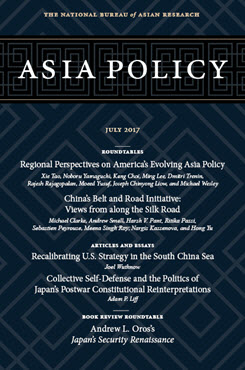Policy by Other Means
Collective Self-Defense and the Politics of Japan's Postwar Constitutional Reinterpretations
This article analyzes Japan’s 2014 landmark cabinet decision reinterpreting the constitution to allow the limited exercise of collective self-defense (CSD) in both a historical and a contemporary context and assesses its implications for the conditions under which Japan may use military force.
EXECUTIVE SUMMARY
MAIN ARGUMENT
In July 2014, a historic cabinet decision reinterpreted Article 9 of Japan’s 1947 constitution to allow the use of force to aid an ally under attack, overturning 60 years of authoritative constitutional interpretations categorically prohibiting Japan’s exercise of CSD. The decision was followed by a revision of the U.S.-Japan Defense Guidelines and landmark legislation intended to transform Japan’s security policy. Yet the change is evolutionary rather than revolutionary. Japan’s self-imposed precondition for the use of force by the Japan Self-Defense Forces (JSDF) remains uniquely strict: an armed attack posing an existential threat to Japan’s security. Nor is this the first case of a major reinterpretation of Article 9. Though its original wording remains untouched, the article’s effective policy significance has changed repeatedly over 70 years in accordance with shifting domestic political winds and perceived strategic exigencies. Specific to post-2014 developments, understanding what changed and why—especially how Prime Minister Shinzo Abe and his allies’ push for full exercise of CSD failed—elucidates the strategic, political, and normative factors shaping changes to Japan’s security policy and the U.S.-Japan alliance.
POLICY IMPLICATIONS
- While Japan may now legally exercise “limited” collective self-defense, unique, self-imposed conditions appear so strict that the use of force in support of allies or partners outside a defense-of-Japan scenario seems unlikely.
- Security legislation in effect since 2016 opens up space for more expansive JSDF logistical support for U.S. military operations, bilateral planning, and exercises, as well as new authorities that somewhat resemble collective security or CSD operations in peacetime, including use of small arms during UN peacekeeping operations and protection of foreign militaries engaged in activities contributing to Japan’s defense.
- Without formal constitutional revision (at a minimum), however, more ambitious efforts to fundamentally transform Article 9’s interpretation or the scope of scenarios in which Japan can use force overseas are unlikely without major domestic political realignments.
About Asia Policy
Asia Policy is a peer-reviewed scholarly journal presenting policy-relevant academic research on the Asia-Pacific that draws clear and concise conclusions useful to today’s policymakers. Asia Policy is published quarterly in January, April, July, and October and accepts submissions on a rolling basis. Learn more


